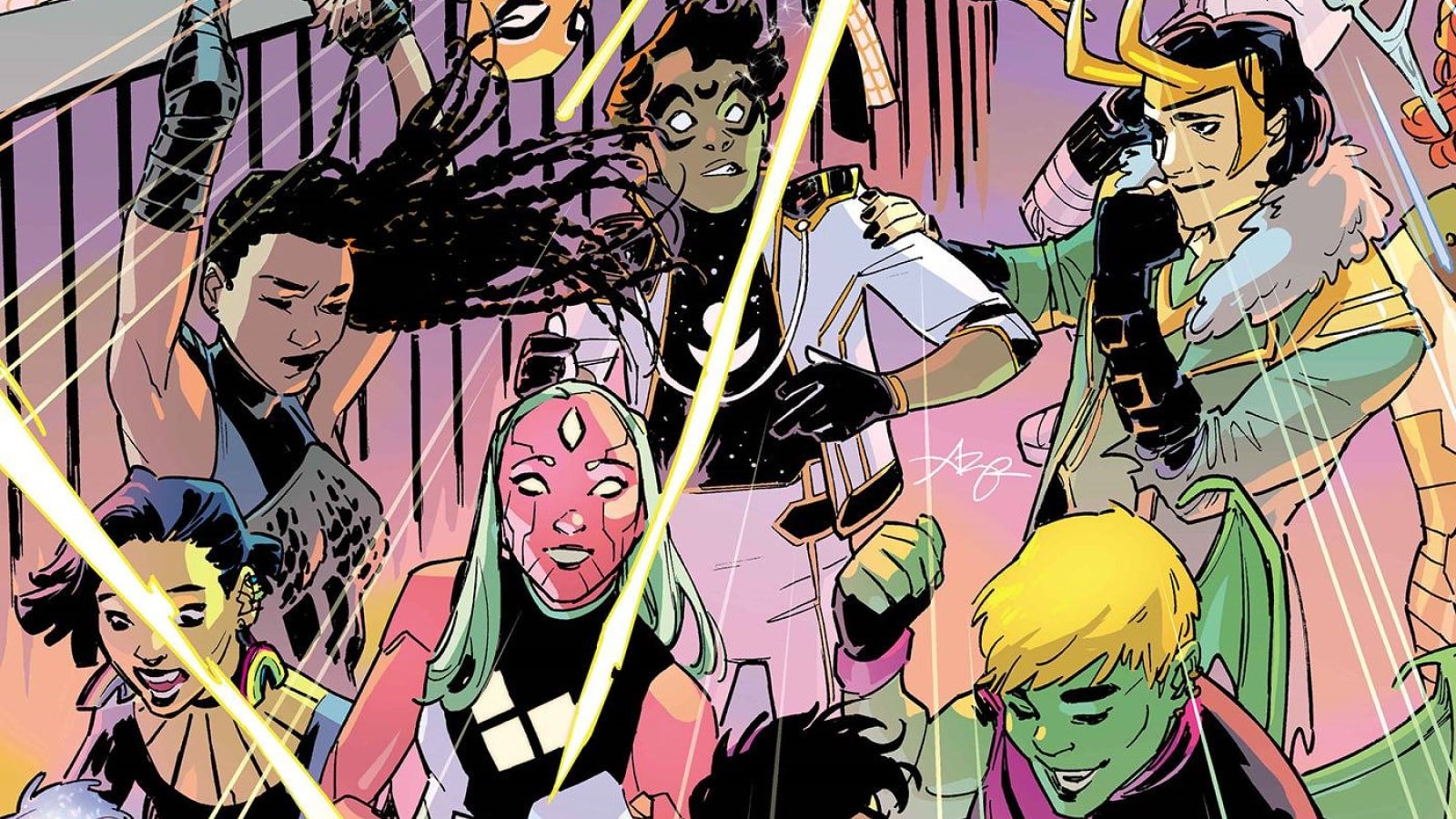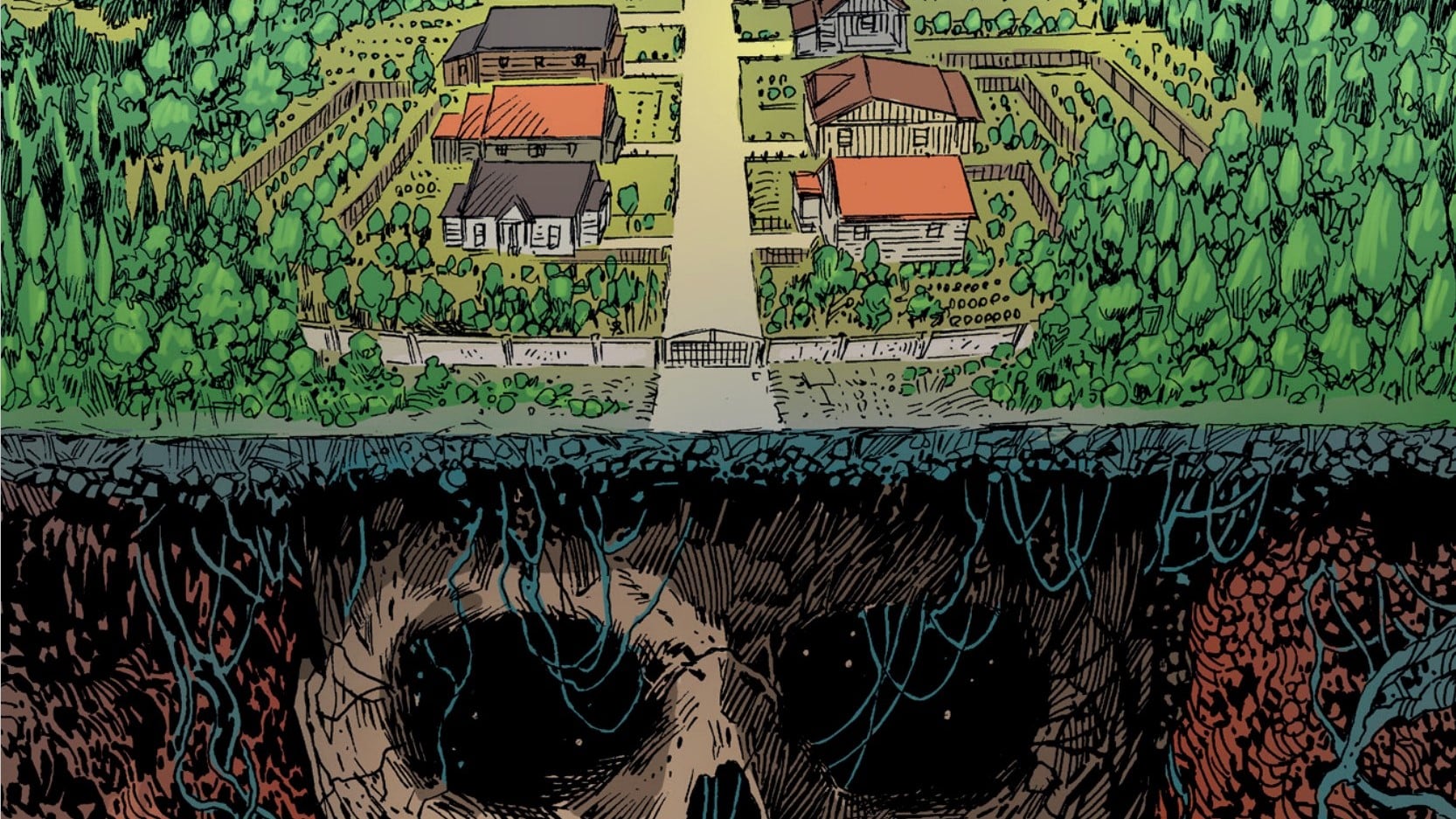
Hedra took my breath away.
I’ve read it three times, each time unearthing something different. It may be wordless, but it’s left me with a lot to say.
Writer and artist Jesse Lonergan is the powerhouse behind Hedra, published by Image Comics. Translating the comic’s name from the ancient Greek, Hedra means “face of a geometrical solid.” It’s something Lonergan uses to his considerable advantage.
Shapes feature prominently to help tell the story of an astronaut who leaves a world ravaged by nuclear weapons in search of life elsewhere. What unfolds is a story of finding something you don’t expect and perhaps can’t understand. Ultimately, it’s a story about connection. At least, that’s what it was for me. You may find something different within its pages.
Ignition Cognition
While there are no words telling readers what to think, the images guide you to explore a world gently steered by Lonergan and you. Hedra opens with an instantly recognizable object. The missile. Then the mushroom cloud. Though most of us have likely never seen a rocket in real life (hopefully), we can identify it. That’s because at some point in our lifetime we’ve come across the image of a missile and stored this knowledge in our brain. This is called semantic memory. This differs from episodic memory, which would call upon our brain to invoke a personal experience associated with the object.
Earth. Shape. Round. Blue. Ocean. Geometric solids.

The brain begins to form neural pathways to identify and categorize objects to help us make sense of this wild and wacky place we call home. The brain does this through the creation of a semantic map. This helps us organize and group similar objects together; in turn this aids in our ability to recall information quickly.
To understand and derive meaning from images, I say, “Hey, brain! What do I know about this object? Where is this object usually found? What other visual or contextual cues are available to tell me what is happening in this panel?”
Once we understand this part, the what of the comic, we can begin to understand the why. The comic narrative is always changing. As a comic narrative progresses we both look forward and backward as readers. We update our understanding of the narrative as we gain more information, panel by panel. The ability for us to relate to our engagement in a comic can change depending on our experiences, interest and attention. That’s what makes comics neat. What I bring to reading Hedra may not be what you bring. It depends on our ability, intentions and what resources (like attention) are currently available. This dynamic is best explained by cognitive scientist Neil Cohn:
“Comprehenders access semantic information about objects and events in images. A narrative grammar assigns images categorical roles and groups them into hierarchic constituents so that semantic information can be organized sequentially and construct a coherent situation model…”
The narrative grammar, like the panel grid layout, tells you how this information should be read. It involves a dialogue between the reader and the artist. It calls upon the reader to use their short- and long-term memory and affects both semantic memory and episodic (sometimes referred to as autobiographical memory). It’s a song and dance, and that’s precisely what Hedra is.
Dance
Hedra calls upon readers to dance between perception, memory, time and space, each element invoked using subtle cues. The constant construction and deconstruction of geometric shapes moves us between the abstract and the concrete. As such, we’re continually shifting our understanding. We are regularly called upon to use the different parts of the brain, specifically the inferior temporal cortex. That’s where our knowledge of objects and our memory meet.
The 35-panel page oddly never feels overwhelming. Despite there being whitespace between the panels, the brain wants to fill it in to create a complete story. As Hedra evolves its narrative, you notice this white space less. When the white space suddenly disappears, it is almost jarring. A beautiful visual trick that demonstrates one of the most gorgeous components of the book, the depiction of time and space.
Time & Space

Traveling through space is signified through thin white lines. We imagine the rocketship dancing from planet to planet, almost bouncing. The free-flowing nature of the lines invokes the concept of the weightlessness of space. Space is represented through the use of circles.

Time in Hedra is signified using a different method, seen on Page 18. Each square represents a unit of time — a theme consistent throughout the one-shot. Lonergan has highlighted three panels here, and by doing so, he ensures we recognize and contextualize these images first.
First, the astronaut walks down the stairs. She then looks back up at the ship. Lastly, she walks away from the ship and out onto the planet’s surface to explore.

As the narrative progresses, the geometric shapes become more complex, time and space begin to meld. It’s never confusing because the comic has guided us gently down this path. Then there are moments where we are dealing with almost fully abstract objects.

The brain wants to derive meaning from what it sees. No, it needs to. A block of squares stacked together, surrounded by other squares. This reminds me of a building. What do I know about buildings? They tend to be tall and structurally sound, making them easy to land on. They also are surrounded by other objects of similar shapes and materials, if not similar sizes. What Lonergan has drawn here may or may not be a building, but I can’t help but come to any other conclusion. In other words: “You shall know an object by the company it keeps.”
Connect
Hedra is a story of connecting through the unknown and the unseen. We communicate connection and intention through our actions by how we move in time and space. Hedra is a richly layered experience that begins with an object, a few colors and shapes. It evolves and builds until its final crescendo — a single piercing tone.
" data-author-type="
Warning: Undefined array key "type" in /home4/xavierf2/public_html/wp-content/plugins/molongui-authorship/views/author-box/html-layout.php on line 18
" data-author-archived="
Warning: Undefined array key "archived" in /home4/xavierf2/public_html/wp-content/plugins/molongui-authorship/views/author-box/html-layout.php on line 19
">
Warning: Undefined array key "id" in /home4/xavierf2/public_html/wp-content/plugins/molongui-authorship/views/author-box/html-layout.php on line 39
-"
Warning: Undefined array key "archive" in /home4/xavierf2/public_html/wp-content/plugins/molongui-authorship/views/author-box/html-layout.php on line 40
itemscope itemid="" itemtype="https://schema.org/Person" >
Warning: Undefined array key "img" in /home4/xavierf2/public_html/wp-content/plugins/molongui-authorship/views/author-box/parts/html-avatar.php on line 4
Warning: Undefined array key "show_social_web" in /home4/xavierf2/public_html/wp-content/plugins/molongui-authorship/views/author-box/parts/html-socialmedia.php on line 6
Warning: Undefined array key "show_social_mail" in /home4/xavierf2/public_html/wp-content/plugins/molongui-authorship/views/author-box/parts/html-socialmedia.php on line 7
Warning: Undefined array key "show_social_phone" in /home4/xavierf2/public_html/wp-content/plugins/molongui-authorship/views/author-box/parts/html-socialmedia.php on line 8
Warning: Undefined array key "type" in /home4/xavierf2/public_html/wp-content/plugins/molongui-authorship/views/author-box/parts/html-name.php on line 17
Warning: Undefined array key "type" in /home4/xavierf2/public_html/wp-content/plugins/molongui-authorship/views/author-box/parts/html-name.php on line 19
Warning: Undefined array key "type" in /home4/xavierf2/public_html/wp-content/plugins/molongui-authorship/views/author-box/parts/html-name.php on line 21
Warning: Undefined array key "archive" in /home4/xavierf2/public_html/wp-content/plugins/molongui-authorship/views/author-box/parts/html-name.php on line 37
Warning: Undefined array key "name" in /home4/xavierf2/public_html/wp-content/plugins/molongui-authorship/views/author-box/parts/html-name.php on line 41
Warning: Undefined array key "bio" in /home4/xavierf2/public_html/wp-content/plugins/molongui-authorship/views/author-box/parts/html-bio.php on line 8





